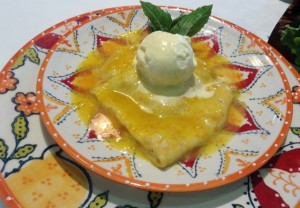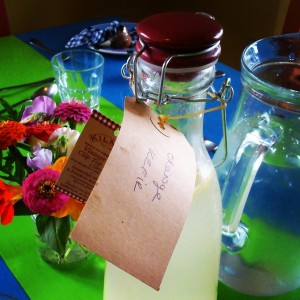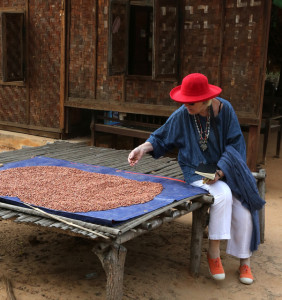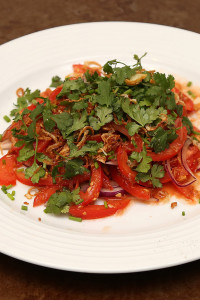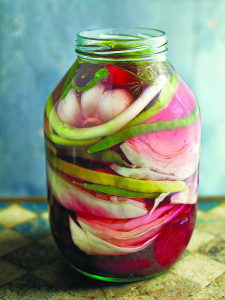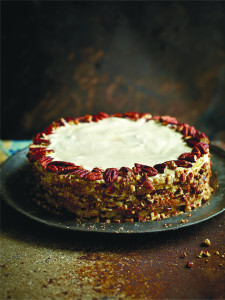Shrove Tuesday is just around the corner again – a perfect excuse to have a pancake party – what fun that is….
The tiny tots love it, teens have fun and the ‘wrinkles’ reminisce about pancakes in the past. So where did the custom come from?  The name Shrove Tuesday originally came from the word Shrive meaning to absolve. Christians were encouraged to examine their conscience, confess and repent before the penitential season of lent commenced on Ash Wednesday. Fasting was an integral part of Lent so it became a custom to use up all the sugar, butter, flour and eggs before the long period of fast and abstinence began.
I hadn’t quite realised how many countries celebrate Shrove Tuesday. In Germany it’s called Fastnachtsdienstag and some other equally unpronounceable words. In Netherlands, it’s known as Vastenavond and is also linked to a carnival. In Portuguese, Spanish and Italian speaking countries it’s actually known as Carnival which is derived from the Latin ‘farewell to the flesh’. In Brazil the Carnival in Rio is the most famous while Venice they celebrate with a masquerade. In Spain, Carnival Tuesday is named ‘dia de la tortilla’, omelette day. In Portuguese-speaking Madeira, they eat malasadas on Terca – feera Gorda – Fat Tuesday and on and on it goes…
In Denmark and Norway the day is called Fastelavn, children dress up in costumes and gather treats. Iceland  calls it  Sprengidagur – Bursting Day and is marked by the tradition of eating peas and salted meat.
In Sweden Fettisdagen – Fat Tuesday is celebrated by eating a marzipan filled pastry called semla. The Lithuanian’s celebrate the day called Užgavènês by eating pancakes or  a special type of doughnut and then of course there’s Mardi Gras in New Oreleans which again means Fat Tuesday and on it goes.
There are pancake races and pancake flipping competitions in many countries so let’s get in on the act. I love the simple pancakes of my childhood which my own grandchildren also love to help to cook and flip but here are some other recipes to choose from if you’d like to ring the changes before you consider 40 days of abstinence!
Hot Tips
10 Great Brunch Recipes, Friday 5th February 2.30pm
Brunch, more substantial than a breakfast is the perfect meal for enjoying quality time with family and friends and enjoying hassle-free entertaining.
For the last number of years we have run an extremely popular breakfast course here at Ballymaloe Cookery School, but never get a chance to share the wonderful repertoire of brilliant brunch ideas that Darina has picked up on her travels… until now! From spicy Sri Lankan chilli eggs to the classic Mexican huevos rancheros, light-as-a-feather ricotta hot cakes with honey, all-American Corn cakes or Dutch pancakes with crisp home cured bacon or tangy blueberry drop scones dripping with fresh butter. Home cooks will head away with so many simply delicious recipes to entertain and delight. www.cookingisfun.ie
Past Ballymaloe Cookery School student
Jack Crotty, aka The Rocket Man, has opened E A S T an exciting new food venue at the Old Winthrop Arcade, Oliver Plunkett Street, Cork City. Super tasty falafel and in house flatbreads with pickles, cheeses and slaws. Open 7 days a week. www.therocketman.ie
Weston A. Price Foundation
Don’t miss the 2nd annual food and nutrition conference at Thomond Park, Co Limerick on February 6th and 7th 2016, focuses on wise traditions in food, farming and the healing arts. Visit the website for full details http://www.wapfmunster.com/
Get Blogging with Lucy Pearce
Join pro-blogger Lucy Pearce and some of our 12 Week Certificate Students for ‘Get Blogging’ on Saturday February 6th. Join Lucy from 2pm-5pm for a whistle-stop tour of the food blogging world and see what’s hot, and what’s not, right now. You’ll see just how diverse food blogging is, and how to find your niche! Lucy will compare the different blogging platforms, highlighting their pros and cons so that you can select the best one for your food blog. www.cookingisfun.ie
Â
Crêpes with Orange Butter
This crêpe recipe is very nearly as good as those Crêpes Suzette they used to serve with a great flourish in posh restaurants when I was a child. These crêpes are half the bother and can be made for a fraction of the cost.
Serves 6 – makes 12 approximately
Pancake Batter
6oz (175g/generous 1 cup) white flour, preferably unbleached
a good pinch of salt
1 dessertspoon (2 American teaspoons) castor sugar
2 large eggs and 1 or 2 egg yolks, preferably free range
scant 15fl oz (450ml/2 cups) milk, or for very crisp, light delicate pancakes, milk and water mixed
3-4 dessertspoons (6-8 American teaspoons) melted butter
Orange Butter
6oz (175g/1 1/2 sticks) butter
3 teaspoons finely grated orange rind
6oz (175g/1 1/3 cups) icing sugar
freshly squeezed juice of 5-6 oranges
8 inch (20.5cm) non-stick crêpe pan
Â
First make the batter.
Sieve the flour, salt, and sugar into a bowl, make a well in the centre and drop in the lightly beaten eggs. With a whisk or wooden spoon, starting in the centre, mix the egg and gradually bring in the flour. Add the liquid slowly and beat until the batter is covered with bubbles. (If they are to be served with sugar and lemon juice, stir in an extra tablespoon of castor sugar and the finely grated rind of half a lemon).
Let the batter stand in a cold place for an hour or so Рlonger will do no harm. Just before you cook the cr̻pes stir in 3-4 dessertspoons (6-8 American tablespoons) melted butter. This will make all the difference to the flavour and texture of the cr̻pes and will make it possible to cook them without greasing the pan each time
Next make the orange butter.
Cream the butter with the finely grated orange rind. Then add the sifted icing sugar and beat until fluffy.
Make the crêpes in the usual way.
Heat the pan to very hot, pour in just enough batter to cover the base of the pan thinly.
* A small ladel can also be very useful for this, loosen the crêpes around the edge, flip over with a spatula or thin egg slice, cook for a second or two on the other side, and slide off the pan onto a plate. The crêpes may be stacked on top of each other and peeled apart later.
They will keep in the fridge for several days and also freeze perfectly. If they are to be frozen it’s probably a good idea to put a disc of silicone paper between each for extra safety.
Note: If you have several pans it is perfectly possible to keep 3 or 4 pans going in rotation. Only necessary if you need to feed the multitudes.
To Serve
Melt a blob of the orange butter in the pan, add some freshly squeezed orange juice and toss the pancakes in the foaming butter. Fold in half and then in quarters (fan shapes). Serve 2 or 3 per person on warm plates. Spoon the buttery orange juices over the top. Repeat until all the pancakes and butter have been used.
Note: A tablespoon (1 American tablespoon + 1 teaspoon) of orange liqueur eg. Grand Marnier or Orange Curacao is very good added to the orange butter if you are feeling very extravagant!
Crêpes with Chocolate Spread, Toasted Hazelnuts and Cream
Spread a little chocolate spread (Green and Blacks) in the middle of the crêpe, top with a blob of cream and sprinkle with chopped toasted hazelnuts.
Crêpes with Chocolate Spread, Kumquat Compote and Cream
Spread a little chocolate spread (Green and Blacks) over each crêpe. Top with a little kumquat compote (see recipe). Fold in half and then in quarters (fan shapes). Serve with softly whipped cream.
Crêpes with Mascarpone and Kumquat Marmalade
250g (9oz) mascarpone
1 tablespoon honey
Juice of 1/2 lemon
Kumquat Marmalade or Kumquat Compote (see recipe)
Mix the mascarpone with the honey, add the freshly squeezed lemon juice and mix to combine. Spread a layer on a warm crêpe. Drizzle some kumquat marmalade or kumquat compote over the top. Fold or roll up and enjoy. Alternatively serve bowls of mascarpone, maple syrup and kumquat marmalade or compote with the hot crêpes so guests can assemble themselves.
Kumquat Compôte
A gem of a recipe, this compôte can be served as a dessert or as an accompaniment to roast duck, goose or glazed ham. Also delicious with goat’s cheese or yoghurt.
Serves 6-20 depending on how it is served
235g (8 1/2 oz) kumquats
200ml (7fl oz/1 cup) water
110g (4oz/1/2 cup) sugar
Slice the kumquats into four or five round depending on size, remove the seeds. Put the kumquats into a saucepan with the water and sugar and let them cook very gently, covered, for half an hour or until tender.
Serve warm or cold.
Note: This compote keeps for weeks in the fridge.
Â
Russian Fluffy Pancakes
Julija Makejeva, who works with us at the Cookery School, taught me how to make these pancakes, known as oladushki in Russian.
Serves 6
225ml (8fl oz) buttermilk
1 level teaspoon bicarbonate of soda (baking soda or bread soda)
2 organic eggs, whisked
scant 1â„2 teaspoon salt
2 teaspoons caster sugar
250g (9oz) white flour
2 tablespoons vegetable oil
Put the buttermilk into a bowl, sprinkle the bicarbonate of soda on top and leave for 3–4 minutes to allow the mixture to bubble.
Whisk the egg, salt and caster sugar into the buttermilk mixture. Slowly add the flour to the batter, whisking all the time, until the mixture has an even consistency. The batter should be very thick and reluctantly fall off the spoon.
Heat a wide frying pan on a medium heat. Add the vegetable oil. Pour a tablespoon of batter into the pan and repeat – you should be able to fit about 5 more pancakes in the pan, spaced evenly apart. Fry until golden brown on one side, flip over once bubbles have appeared on the surface and popped. Repeat the process until all of the batter is used. Serve with sour cream mixed with raspberry jam or sour cream sprinkled with brown sugar.
Semlor Lenten buns
Serves 12
80g (2½oz) melted butter
250ml (9 fl oz) whole milk
25g (¾ oz) fresh yeast (or 12g active dry yeast)
40g (1½ oz) caster sugar
400 g (10½ oz) plain bread flour, plus extra for dusting
½ tsp salt
1 tsp baking powder
2 tsp ground cardamom
1 egg, lightly beaten
Filling
100g (3½ oz) almond paste, see recipe
6-8 tablespoons of custard, see recipe
500ml (18 fl oz) whipping cream
1 tsp vanilla sugar or extract
Icing sugar to dust
If using mixer, set it up with the dough hook attachment. Melt the butter and add the milk, ensuring a lukewarm (blood) temperature. Add the fresh yeast and stir until dissolved.
Add sugar and stir again. Add 300 g of flour as well as the salt, baking powder and ground cardamom. Add  ½ the egg (preserve the other half for brushing before baking).
Mix well until all ingredients are incorporated and then start to add remaining 100 g of the flour, bit by bit, until you have a dough that is only a little bit sticky. Take care not to add too much flour: you will get dry buns. Knead the dough for at least five minutes in the mixer, longer by hand. Leave to rise in a warm place until doubled in size, about 40 minutes.
Turn the dough out to a floured surface. Knead again for a few minutes, adding more flour if needed. Cut the dough into 12 equal sized pieces. Take care that the balls are completely round and uniform in size. Place on baking tray with good spacing between buns. Leave to rise for another 40-50 minutes.
Preheat the oven to 200°C/400°F/gas mark 6.
Gently brush each bun with the remainder of the egg wash and bake in a hot oven for about 20 minutes or until baked through – keep an eye on them as they can burn quickly. Remove from oven and cover the tray with a lightly damp tea towel immediately – this will prevent the buns from forming a crust.
When the buns have cooled down completely, cut a ‘lid’ off the buns – about 1½ cm from the top. Scoop out about ⅓ of the inside of the bun and place crumbs in a separate bowl.
Mix the almond paste with the crumb until it forms a very sticky mass –add a dash of milk or custard  at this point to help it along. You want a spoonable even mixture.
Spoon the filling back into the buns, equally divided. Whip the cream with the vanilla sugar until stiff and use a piping bag to pipe cream on all the buns’ tops. Put the ‘lids’ back on and dust with icing sugar.
Almond Paste
225 g (½ lb) ground almonds
225 g (½lb) golden castor sugar
1 small organic or free-range egg
a drop of pure almond extract (really careful, its very intense)
1 tablespoons (2 1/2 American tablespoons) Irish whiskey
Sieve the castor sugar and mix with the ground almonds. Beat the eggs, add the whiskey and 1 drop of pure almond essence, then add to the other ingredients and mix to a stiff paste. (You may not need all of the egg). Sprinkle the work top with icing sugar, turn out the almond paste and work lightly until smooth.
Crème Anglaise (Custard Sauce)
This basic sauce is usually flavoured with vanilla but can be make with any number of other ingredients, such as lemon or orange rind or mint. It is used in many recipes including ice-cream, though in that case the proportion of sugar is much higher than usual because unsweetened cream is added during the freezing.
1 pint (600 ml/2 1/2 cups) milk
vanilla pod or other alternative flavouring
6 egg yolks
2 ozs (50g/ 1/4 cup) sugar
Bring the milk almost to the boil with the vanilla pod. Beat the egg yolks with the sugar until thick and light. Whisk in half the hot milk and then whisk the mixture back into the remaining milk. Cook over very low heat, stirring constantly with a wooden spoon, until the custard thickens slightly. Your finger should leave a clear trail when drawn across the back of the spoon.
Remove from the heat at once and strain. Cool, cover tightly and chill. The custard can be kept up to 2 days in the refrigerator.
Â
Malasadas
These Portuguese-style raised doughnuts are super-popular in Hawaii.
Makes 24 large doughnuts
3 large eggs, room temperature
5½ oz (160 g/3/4 cup) sugar
5 oz (140 g) salted butter
1 lb 2 ox (500 g/5 1/2 cups) all-purpose flour, plus extra for dusting
½ oz (14 g) quick-rising dry yeast
8 fl oz (200 ml/1 cup) hot water (40°C)
2½ fl oz (65 ml/1/3 cup evaporated milk
2 teaspoons vanilla extract
Vegetable oil (for deep-frying)
Additional sugar – caster, cinnamon or vanilla
Put 1 egg, sugar, butter and salt in bowl of heavy-duty mixer fitted with dough hook attachment; beat until blended, 1 minute.
Add 5 cups flour and yeast; beat until blended. Add the hot water, milk and vanilla and beat until well blended, 1 minute. Beat in remaining 2 eggs, then 1/2 cup flour. Beat until dough is smooth, soft and slightly sticky but begins to come away from sides of bowl, adding more flour by tablespoonful if very sticky, about 8-10 minutes. Scrape down dough from sides of bowl. Cover bowl with plastic wrap and towel. Let dough rise in warm draft-free area until almost doubled in volume, about 1½-2 hours.
Punch down dough. Cut into 2 equal pieces. Roll out 1 piece on lightly floured surface to 12×16-inch rectangle. Cut lengthwise into 3 strips and crosswise into 4 strips, making twelve 4-inch squares. Repeat with remaining dough.
Pour enough oil into large saucepan to reach depth of 1 1/2 inches.
Attach deep-fry thermometer and heat oil to 350°F. Fry 2 or 3 malasadas until puffed and golden brown, turning once, about 3 minutes. Using slotted spoon, transfer malasadas to paper towels and drain.
Repeat frying with remaining dough squares, heating oil to 350°F for each batch.
Generously sprinkle warm malasadas with additional sugar. Serve warm or at room temperature.

